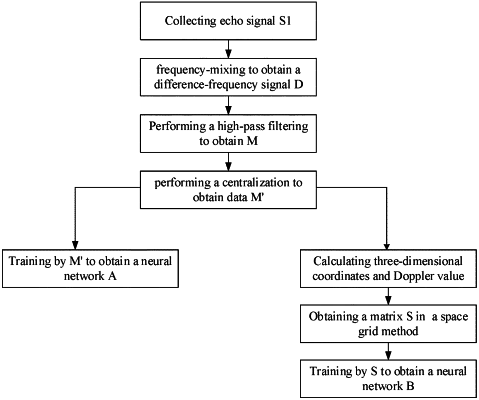| CPC G01S 13/89 (2013.01) [G01S 13/505 (2013.01); G01S 13/53 (2013.01); G06F 3/017 (2013.01); G06F 21/32 (2013.01); G06N 3/08 (2013.01); H04M 1/026 (2013.01); H04M 1/724631 (2022.02)] | 7 Claims |

|
1. A method for recognizing an identity and a gesture based on radar signals, including following steps:
Step 1, reading a radar echo signal reflected by various gestures of a tester and received by a radar sensor;
Step 2, frequency-mixing the radar echo signal with a radar transmission signal;
Step 3, filtering a frequency-mixed signal by a high-pass filter;
Step 4, performing a centralization operation on filtered signal data;
Step 5, determining a neural network model suitable for features of the radar signal, training the model by using a preprocessed signal in the Step 4 and an identity information label of the tester, to obtain a neural network A for identity verification;
Step 6, obtaining distance information, speed information and angle information, according to the preprocessed signal in the Step 4 and parameters of the radar sensor, to calculate three-dimensional coordinates and Doppler values of a moving target;
Step 7, dividing space above a radar in a space grid method; mapping a spatial area into a three-dimensional matrix; determining a grid position where the moving target is located in the space, according to the three-dimensional coordinates obtained in the Step 6; accumulating the Doppler values obtained in the Step 6 at a matrix unit corresponding to the grid position, as a size of an element of the matrix unit; training a designed neural network by the matrix and a gesture information label, to obtain a neural network B for gesture recognition;
Step 8, performing a constant false alarm rate detection on the radar echo signal detected in real time, to determine whether a gesture recognition is performed; and if the gesture recognition is performed, proceeding to the Step 9; otherwise continuing to wait for detection;
Step 9, performing a preprocessing of the Steps 2 to 4 on the detected radar echo signal; sending the processed signal to the neural network A trained in the Step 5, to extract features for analysis; verifying an identity of a user through identity information contained in the features; and if the identity is verified, determining that the gesture of the user is valid and proceeding to Step 10, otherwise continuing to wait for detection; and
Step 10, performing a processing of the Steps 6 and 7 on the data preprocessed in the Steps 2 to 4, and inputting the processed data to the neural network B, to determine a gesture of a user and to perform a corresponding operation according to a correspondence between the gesture of the user and an operation,
wherein in the Step 6, the distance information R is obtained through a fast time dimension FFT, according to the preprocessed signal in the Step 4 and the parameters of the radar sensor:
 the speed information v is obtained through a slow time dimension FFT:
 wherein fmovingBeat and fstaticBeat are frequencies of beat signals when a target is in motion and static states respectively, fd is a Doppler frequency, fc a span, R is a distance to the target, C is a speed of light, tc is a frequency sweep period, f is a center frequency of a Chirp signal, and v is a speed of the target; and
the angle information θ is obtained according to a plurality of transmitting and receiving antennas of the radar sensor:
 wherein Δd is a distance difference between any two receiving antennas and the target, ΔΦ is a phase difference of signals received by two corresponding antennas, L is a distance between the two corresponding antennas, and λ is a wavelength.
|